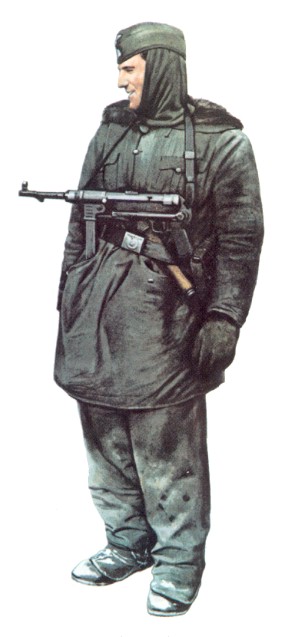


|
As a fighting unit Gro�deutschland was formed in 1939. The core of this four battalion infantry regiment came from the "Wachtregiment Berlin", a guard unit used for ceremonial purposes. The rest of the regiment came from volunteers from all areas of Germany. Thus the name Gro�deutschland was used meaning "Greater Germany". The unit's first designation was "Infanterie-Regiment Gro�deutschland". At the outbreak of war with Poland the regiment was still in the midst of reorganization. Infanterie-Regiment Gro�deutschland was to stay home and continue the reorganization during the Polish campaign. On 6 September 1939 it was heard that the unit was to be air-landed into Poland. This operation was cancelled due to the advance of Soviet troops into eastern Poland which made the operation unnecessary. In August 1940 the black cuff title Gro�deutschland was issued to the unit and they were now a motorized formation. Although Infanterie-Regiment Gro�deutschland was ready, they did not participate in the immediate invasion of France. However the unit did see some action during the campaign while fighting under the leadership of Heinz Guderian's 19th Armeekorp. Later they were attached to Kleist's command. Gro�deutschland took part in the invasion of Yugoslavia in April 1941 and then by 22 June, 1941 they headed into Russia during operation Barbarossa. In this campaign they were part of the 2nd Panzerarmee. Distinguishing itself in combat, Gro�deutschland was one of the few German units to reach the out skirts of Moscow. Following the harsh winter battles from Tula to Orel, Gro�deutschland served as an excellent fighting unit while suffering heavy casualties. As a result the unit under went several reorganizations. By April 1942 Armored units were added for better support. The unit was then reformed as "Infanterie-Division (mot) Gro�deutschland". As a much larger unit Gro�deutschland fought several major engagements ending the year west of Moscow. On 23 June, 1943 Gro�deutschland was designated "Panzer Grenadier Division Gro�deutschland". By this time Gro�deutschland was truly a reinforced Panzerarmee with reconnaissance consisting of Pioneer (engineer) Battalions that were fully armored. During 1943 Gro�deutschland fought at Kharkov, Belgogrod and Kursk during operation Citadel. Later the unit fought in operations north of Karachev in the Orel area. In September 1943, Russian attacks forced Gro�deutschland and other units south across the Dneiper river. These bitterly fought battles sent Gro�deutschland to France for refitting. In 1944 Gro�deutschland fought at Targul Frumos, Poland, Lithuania, and Memel just to name a few places. In November 1944 Gro�deutschland was reformed as "Panzer Korps Gro�deutschland". Fighting in retreating battles Gro�deutschland gained the nickname "Die Feuerwehr" (fire brigade). Suffering heavy casualties Gro�deutschland fought until May 1945. Gro�deutschland repeatedly faced an enemy with far superior forces while inflicting powerful blows to them. Gro�deutschland held their own against enemy superiority in the field. As a World War II combat unit, their legacy left 50,000 dead including 1,500 officers killed in combat. The unit was awarded more Knights Crosses than any other formation in the German Military. |
 
|